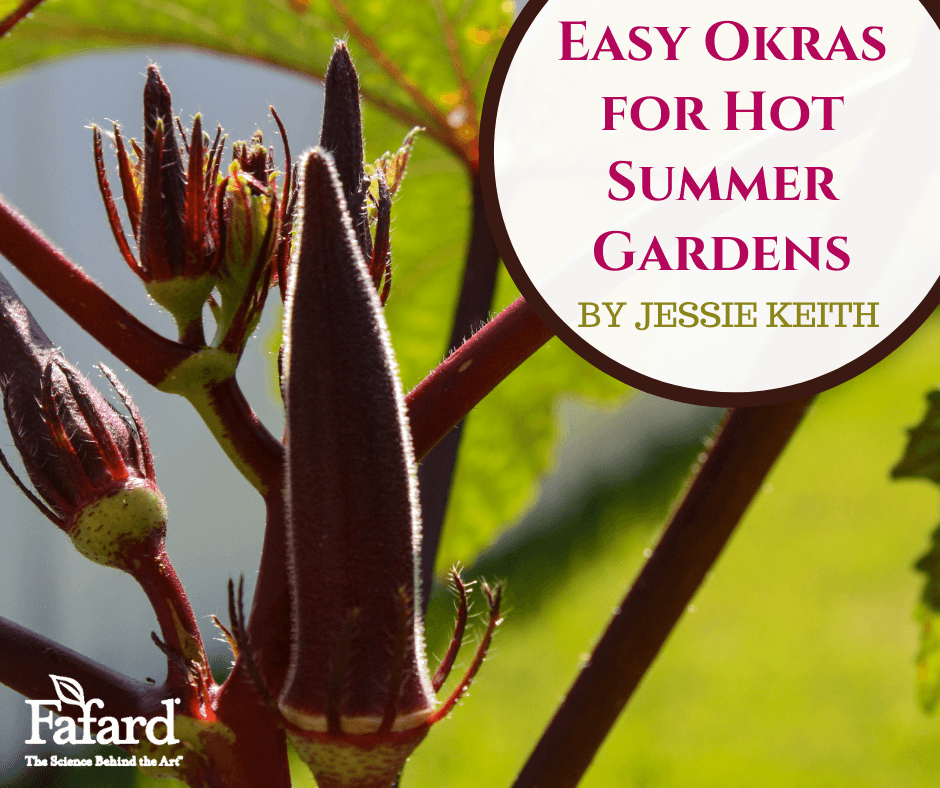
Okra is a southern staple crop for several reasons. The tasty podded vegetable thrives in heat and even drought, and it is so easy to grow. Newer varieties are more tender, prolific, and lack painful spines. As an added bonus, you can let the pods mature and become woody at the end of the season, and then cut them and bring them indoors. They last for years and add an architectural flair to everlasting arrangements.
About Okra

Okra (Abelmoschus esculentus) is a tender perennial with native roots extending from Africa to Southeast Asia. Historically, it was brought to the Americas through the slave trade in the late 1600s and is noted as becoming a southern staple crop in the United States by the early 1800s. It is a nutritious vegetable (technically a fruit) that requires little nurturing to produce pods, so it certainly helped feed those with little resources early on in the South. It is an essential ingredient of Louisiana gumbo and is also enjoyed fried, pickled, and added to mixed meat and vegetable dishes.

The plants are tall, upright, and have large, lobed, palm-shaped leaves. They are members of the hibiscus or mallow family, so their purple-centered, mallow-like flowers of pale yellow, ivory, or pink, are quite pretty when in bloom. Bees are the primary pollinators, so refrain from using pesticides around okra, not that they should be needed. The plants don’t have many severe pest and disease problems, aside from Japanese beetles where these pests are present (click here to learn how to manage Japanese Beetles). Aphids also cause occasional, but not severe, problems. The upright pods should be harvested when they are tender and young. Once they are woody, you can no longer eat them.
Good Okra Varieties

There is a surprising amount of variability in okra forms. Pods may be purple, red, or various shades of green. The most essential traits to seek out are cultivated varieties with numerous tender pods and continuous production. Height is another factor to consider. Some varieties can reach 8 feet high, while compact forms may only reach 3 feet. Here are seven exceptional varieties to try.
- ‘Annie Oakley‘ (53 days from seed to harvest) is the first okra that I ever grew, and it sold me on okra for life. The compact plants produce lots of small to mid-sized okra pods that are green and very tender.
- ‘Bowling Red‘ (57 days from seed to harvest) is a large okra (7-8 feet) that bears lots of long, slender, tasty pods of deep purplish-red. Pods are noted for remaining tender at a larger stage. The variety dates back to 1920s Virginia.
- ‘Carmine Splendor‘ (51 days from seed to harvest) is a high-yielding heirloom with somewhat small, uniform, reddish pods and are fast-to-produce. It should bear fruit from midsummer to late summer or early fall.
- ‘Clemson Spineless‘ (60 days from seed to harvest) is a 4-5-foot heirloom that is noted for being one of the first spineless types developed. Its pale green, pods are tasty and prolific.
- ‘Heavy Hitter‘ (55 days from seed to harvest) is a 5-foot okra that appears to be on steroids because its crops are so large. Single plants are reported to produce as many as 250 pods over a season! Give the large plants plenty of space.
- ‘Jambalaya‘ (50 days from seed to harvest) is compact, early, and bears smaller pods heavily through summer. This is the okra to try if you have little space.
- ‘Louisiana 16 inch‘ (60 days from seed to harvest) has long, palest-green, extra flavorful pods that remain tender for a long time. If you like to eat lots of okra, choose this variety! Keep in mind, it becomes huge (to 8-feet). Some report it growing into the trees, so plan to give it lots of space.

Planting and Growing Okra
Okra grows best in full, hot sun for a minimum of 8 hours per day. It will tolerate poor to average soil, but adding fertile amendments to the garden will boost performance and production while reducing the need to water as often. Fafard Garden Manure Blend is a great amendment for okra planting.
Okra seeds are large, so it is a good direct-sow crop, meaning you can seed them in on-site. Plant them when the soil is warm and the threat of frost has passed. Topping the seeds off with added organic matter provides extra moisture and light cover to help them germinate more readily.
Space plants according, based on their final estimated plant size, and expect them to grow large quickly. Wayward branches can be pruned off to keep plants in bounds. Large plants may require staking, especially if you live in an area where high winds are common.
Harvesting Okra

When it comes to harvest, timing is everything. The pods develop so quickly that they can turn from tender to woody in just a day or two, so plan to pick them daily during harvest season. Harvest them then they are small, tender, and bendable, or squeezable. Cut them from their tender base, and store them in the refrigerator to keep them fresh. The faster you cook the pods, the better they will taste!
As fall becomes chilly, okra stops producing. At this time, I recommend leaving a stem or two to fully mature and dry. The woody stems and fruits add decorative flair to dry arrangements. It is also the perfect time to collect seeds for the following season.

